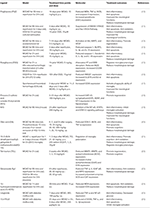It seems to address at least 2 of 5 causes of the neuronal cascade of death in the first week. So this should IMMEDIATELY BE PUT FIRST IN LINE FOR RESEARCH. But that will never occur, we have NO leadership and NO strategy.
The Protective Effects of Peroxisome Proliferator-Activated Receptor Gamma in Cerebral Ischemia-Reperfusion Injury
- 1College of Life Science, Northwest Normal University, Lanzhou, China
- 2College of Life Science, Lanzhou University, Lanzhou, China
Cerebral ischemia-reperfusion injury (CI/RI) is a complex pathological process that often occurs secondary to trauma, surgery, and shock. Peroxisome proliferator activated receptor gamma (PPARγ) is a subunit of the PPAR and is a ligand-activated nuclear transcription factor. After being activated by its ligand, PPARγ can combine with specific DNA response elements to regulate the transcription and expression of genes. It has a wide range of biological functions, such as regulating lipid metabolism, improving insulin sensitivity, modulating anti-tumor mechanisms, and inhibiting inflammation. In recent years, some studies have shown that PPARγ exerts a protective effect during CI/RI. This article aims to summarize the research progress of studies that have investigated the protective effects of PPARγ in CI/RI and the cellular and molecular mechanisms through which these effects are modulated, including inhibition of excitatory amino acid toxicity, reduced Ca2+ overload, anti-oxidative stress, anti-inflammation, inhibition of microglial activation, maintain the BBB, promotion of angiogenesis, and neurogenesis and anti-apoptotic processes.
Introduction
Cerebral ischemia-reperfusion injury (CI/RI) is a pathological process characterized by an initial restriction of blood supply to the brain, followed by the subsequent restoration of perfusion along with concomitant reoxygenation, resulting in severe damage to brain tissue (1). CI/RI is a very common pathophysiological phenomenon in the clinic, and is commonly observed in patients with traumatic injuries or in association with certain disease processes; some examples include hemorrhagic shock, severe surgical trauma, tumor resection, and tissue/organ transplantation (2). CI/RI is associated with certain characteristics that include high degrees of morbidity, disability, and mortality, and a high recurrence rate, which exerts a heavy burden on the patient's family and society as a whole (3). At present, the cellular and molecular mechanisms through which CI/RI occurs have not been fully elucidated, but CI/RI is believed to be related to the production of oxidative free radicals, mitochondrial damage, disorders of energy metabolism, Ca2+ overload, and excitotoxicity (4). These pathological processes aggravate neuroinflammation and promote the activation of microglia, which is followed by the production of multiple pro-inflammatory mediators, such as cytokines, and chemokines involved in inducing changes in blood-brain barrier (BBB) permeability, causing edema, apoptosis, or necrosis.
Peroxisome proliferator-activated receptors (PPARs) are ligand-inducible nuclear transcription factors that belong to the type II nuclear receptor superfamily. PPARs include three heterologous forms, namely PPARα, PPARβ/δ, and PPARγ, with PPARγ being the most intensively studied to date (5). PPARγ is widely distributed throughout the body, mainly in adipose tissue, but it is also expressed in small amounts in the spleen and liver, in monocytes/macrophages, B cells, T cells, and smooth muscle cells (6). In the nervous system, PPARγ is expressed in neurons and glia, including microglia and astrocytes, in multiple brain regions (7). When activated by its ligands, PPARγ can bind to specific DNA-response elements to regulate gene transcription and expression, thereby modulating a variety of physiological functions, including participating in lipid and glucose metabolism, improving insulin sensitivity, and promoting adipocyte differentiation (8).
Recent studies have shown that PPARγ exerts neuroprotective effects in CI/RI by downregulating proinflammatory mediators, modulating selective activation of immune cells, inducing antioxidant expression, participating in the proliferation, and differentiation of neuronal stem cells, increasing the expression of vascular endothelial growth factor (VEGF), maintaining the BBB, and reducing the expression of apoptotic factors (7). At present, PPARs agonists have been used in clinical trials mainly for the treatment of hyperlipidemia, diabetes and metabolic syndrome, and achieved results. A national cohort study showed that Asian patients with ischemic stroke taking pioglitazone for type 2 diabetes mellitus (T2DM) could lower the risks of recurrent ischemic stroke during the long term follow-up. And their data provided the evidence of pioglitazone for secondary prevention of ischemic stroke in Asian T2DM patients, which provides a theoretical basis for the development of new cardiovascular and cerebrovascular disease drugs (9). The research progress of PPARγ agonists in the treatment of CI/RI in the last 5 years is summarized in the Table 1 (10–26).

Table 1. Summation of the research progress of PPARγ agonists in the treatment of CI/RI in the last 5 years.
In this review, we summarize major progress made to date toward understanding the neuroprotective mechanism exerted by PPARγ in CI/RI in terms of its involvement in reducing glutamate toxicity and Ca2+ overload, anti-oxidative stress, anti-inflammation, including its role in inhibiting microglial activation, maintaining the BBB, promoting angiogenesis and neurogenesis, and anti-apoptotic processes.
 Yanping Ding1,
Yanping Ding1,  Jie Kang
Jie Kang
No comments:
Post a Comment